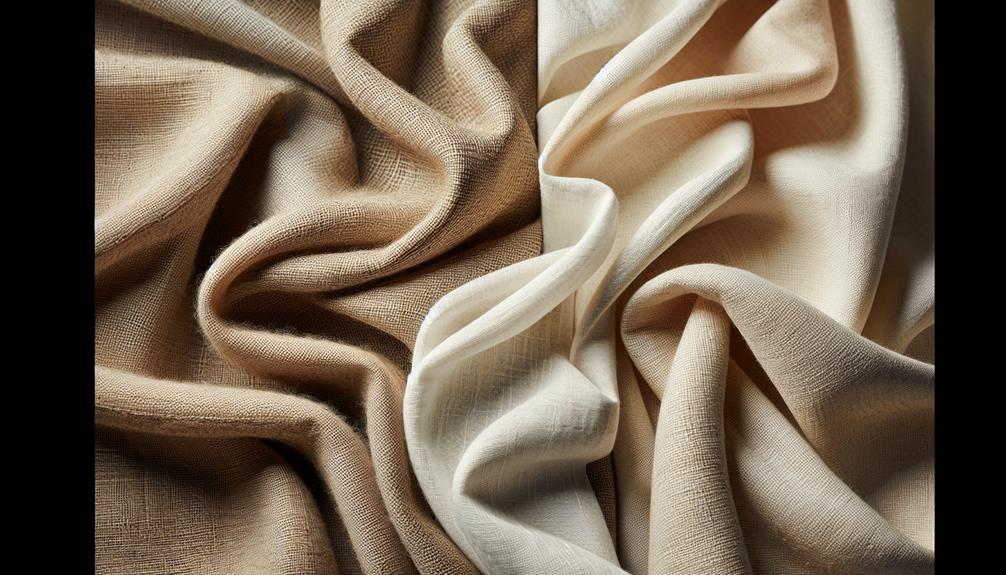Like comparing a sturdy oak tree to a gentle willow swaying in the breeze, understanding the differences between linen and cotton can open a world of possibilities in textiles.
Exploring these natural fibers' unique characteristics can help in making informed choices for various applications. From their origins to how they feel against the skin, each has its own strengths and weaknesses.
So, let's unravel the intricacies of linen and cotton to truly appreciate their distinct qualities and applications.
Table of Contents
Key Takeaways
- Linen is more breathable and dries faster than cotton, making it ideal for hot weather.
- Cotton is softer and provides more insulation, suitable for cooler climates.
- Linen is more durable, sustainable, and eco-friendly due to its cultivation process.
- Linen requires less water, no pesticides, and is biodegradable, reducing its environmental impact.
Origins and Plant Sources
When it comes to the origins and plant sources of linen and cotton, their distinct fibers stem from different parts of their respective plants. Linen, renowned for its strength and durability, originates from the flax plant's stalks. Flax fibers, extracted from the inner bark of the flax plant, are meticulously harvested and processed to create this prized fabric.
On the other hand, cotton fibers, known for their fluffy nature, are sourced from the protective bolls surrounding the seeds of the cotton plant. Cotton primarily comes from the Gossypium species of the cotton plant, cultivated in various regions across the globe.
Understanding these plant sources is important in comprehending the fundamental disparities between linen and cotton, not only regarding their fibers' origins but also the qualities they bring to the world of textiles.
Textural Variances and Feel
Moving from the discussion on the origins and plant sources of linen and cotton, the textural variances and feel of these fabrics offer distinct tactile experiences for consumers.
- Linen's Texture: Linen is renowned for its rough and sturdy texture, providing a unique tactile sensation that's different from cotton. The coarser feel of linen adds a sense of durability and ruggedness to the fabric, making it ideal for certain types of garments or home textiles.
- Cotton's Texture: In contrast, cotton boasts a smooth and flexible texture that's gentle against the skin. The softness of cotton fabric is highly favored for its comfort and versatility, making it a popular choice for various clothing items and bedding.
- Weave Variations: The weave of linen typically tends to be looser, giving it a more textured and crisp feel compared to the tighter weave commonly found in cotton fabrics. This difference in weaving techniques contributes to the distinct tactile qualities of each fabric.
- Textural Appeal: Linen's natural luster enhances its textural appeal, while cotton's soft and pliable texture offers a more luxurious sensation. These textural nuances play a significant role in determining the overall look and feel of garments and household items made from linen and cotton.
Breathability and Moisture Absorption
Discussing the breathability and moisture absorption properties of linen and cotton reveals significant distinctions in their performance and suitability for various climates. Linen, crafted from natural fibers, boasts a more breathable nature than cotton due to its looser weave. This attribute allows for better airflow, making linen garments ideal for hot and humid conditions.
Furthermore, linen excels in moisture absorption, drawing perspiration away from the body and aiding in quick evaporation. In contrast, cotton, while also breathable, tends to retain more moisture than linen. The breathability of linen not only helps in regulating body temperature but also keeps the skin cool and comfortable.
Its moisture-wicking abilities make linen a preferred choice for summer clothing, ensuring the wearer stays dry and fresh even in sweltering weather. Moreover, when prioritizing breathability and moisture absorption, linen emerges as the superior option among these two natural fiber textiles.
Warmth and Insulation Properties
When it comes to warmth and insulation, understanding the differences between linen and cotton is essential.
Linen excels at keeping me cool in hot weather by promoting air circulation, while cotton shines in providing insulation and retaining warmth, especially in cooler climates.
Knowing which fabric to choose based on their unique properties can make a significant difference in my comfort throughout the seasons.
Insulation in Cold
Linen excels in providing natural insulation in cold weather, trapping body heat and maintaining warmth effectively. When comparing linen and cotton for insulation in cold conditions, here are some key points to bear in mind:
- Thermal Properties: Linen's natural fibers have excellent thermal properties, making it ideal for retaining heat and keeping you warm.
- Dense Weave: The dense weave of linen fabric acts as a barrier against cold air, providing extra insulation and a cozy feel.
- Winter Garments: Linen is a preferred choice for winter garments due to its superior insulation capabilities.
- Bedding: Linen bedding offers warmth and comfort, ensuring a snug sleep even in chilly weather.
In cold climates, linen's insulation properties outshine cotton, making it a top choice for staying warm and cozy.
Breathability in Warmth
In shifting from discussing insulation in cold weather to the topic of breathability in warmth, it becomes apparent that linen's natural properties play a pivotal role in maintaining comfort across varying climates. Linen stands out for its exceptional breathability, making it an ideal choice for warmth in hot climates. Its ability to conduct heat away from the body and allow for air circulation guarantees temperature regulation and comfort. On the other hand, cotton, while also breathable, may retain more moisture, making it better suited for moderate warmth. The table below highlights the key differences in breathability and warmth properties between linen and cotton:
| Properties | Linen | Cotton |
|---|---|---|
| Breathability | Highly breathable, ideal for hot climates | Breathable, suitable for moderate warmth |
| Temperature Regulation | Excellent in regulating temperature, stays cool in hot weather | Versatile, offers comfort and moderate insulation |
Durability and Longevity
I find it fascinating how linen's durability surpasses that of cotton, lasting for years when properly cared for. The way linen fibers gradually grow softer and more robust with time truly sets it apart regarding longevity.
On the contrary, cotton's tendency to wear out quicker, especially with frequent washing, highlights the stark difference regarding their endurance levels.
Fiber Strength
When considering fiber strength in textiles, one can observe a notable difference between linen and cotton.
- Linen is the strongest natural fiber, approximately 30% stronger than cotton due to its thicker fibers and lower thread count requirement for quality.
- Cotton, although soft and comfortable, is less durable than linen and more prone to pilling over time.
- Linen becomes softer and stronger with use, making it a long-lasting and luxurious choice for various products.
- Cotton, while versatile for all seasons, may wear out faster compared to linen with frequent washing and use.
Linen's robustness and durability make it a preferred choice for those seeking long-lasting and high-quality textiles.
Wear and Tear
With proper care and maintenance, linen typically outlasts cotton due to its inherent durability and strength. Linen's durable nature makes it a long-lasting fabric, capable of enduring decades of use.
In contrast, cotton, with its softer fibers, may wear out faster than linen, showing signs of deterioration earlier. Linen's longevity is further enhanced by its ability to become softer and stronger over time, maintaining its quality even with frequent use.
Additionally, linen's resistance to moths and carpet beetles adds to its durability, ensuring a prolonged lifespan. When considering wear and tear, linen emerges as the more durable choice, offering both longevity and resilience compared to cotton's tendency to show wear sooner due to its softer nature.
Environmental Impact and Sustainability
Regarding environmental impact and sustainability, linen outperforms cotton due to its much lower water usage and absence of pesticides. Here are four key reasons why linen is considered a more eco-friendly fabric option compared to cotton:
- Water Conservation: The cultivation of flax, the plant used to make linen, requires far less water than the production of cotton. This makes linen a more sustainable choice when it comes to water resources.
- Pesticide-Free: Unlike cotton, which often relies heavily on pesticides during cultivation, linen can be grown without the need for these harmful chemicals. This reduces the environmental impact of linen production.
- Lower Environmental Impact: The overall cultivation process of flax for linen is known to have a lower environmental impact compared to cotton production. Choosing linen over cotton can help reduce the ecological footprint of the textile industry.
- Biodegradability and Recyclability: Linen is biodegradable and recyclable, making it a more environmentally friendly option. Its ability to decompose naturally and be reused contributes to its sustainability profile, further reducing its carbon footprint.
Frequently Asked Questions
Which Is Better Linen or Cotton?
In my opinion, when choosing between linen and cotton, it really depends on personal preferences and needs. Both fabrics have their unique qualities, and what's "better" will vary based on individual priorities and requirements.
Is 100% Cotton the Same as 100% Linen?
No, 100% cotton is not the same as 100% linen. Each has distinct properties due to their different plant sources. Cotton is softer and more flexible, while linen is durable and lustrous. Understanding these differences is essential.
Is Linen or Cotton Better for Hot Weather?
In hot weather, linen surpasses cotton with its breathability, moisture-wicking, and heat dissipation. It keeps me cool and comfortable by quickly absorbing and drying moisture, making it an ideal choice for staying fresh in warm climates.
Why Is Linen More Expensive Than Cotton?
Linen costs more than cotton due to labor-intensive flax harvesting and processing. Flax cultivation is meticulous. Linen production involves retting, scutching, and combing. Its scarcity, unique properties, durability, and luxurious feel justify the higher price.
- Recycling Nonwoven Fabrics: Is It Possible? - July 11, 2025
- Recycling Nonwoven Fabrics: Is It Possible? - July 11, 2025
- Recycling Nonwoven Fabrics: Is It Possible? - July 11, 2025




